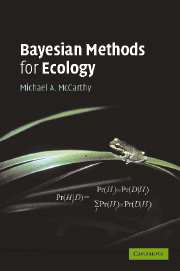Book contents
- Frontmatter
- Contents
- Preface
- 1 Introduction
- 2 Critiques of statistical methods
- 3 Analysing averages and frequencies
- 4 How good are the models?
- 5 Regression and correlation
- 6 Analysis of variance
- CASE STUDIES
- APPENDICES
- A A tutorial for running WinBUGS
- B Probability distributions
- C MCMC algorithms
- References
- Index
B - Probability distributions
Published online by Cambridge University Press: 05 June 2012
- Frontmatter
- Contents
- Preface
- 1 Introduction
- 2 Critiques of statistical methods
- 3 Analysing averages and frequencies
- 4 How good are the models?
- 5 Regression and correlation
- 6 Analysis of variance
- CASE STUDIES
- APPENDICES
- A A tutorial for running WinBUGS
- B Probability distributions
- C MCMC algorithms
- References
- Index
Summary
There are many excellent texts on probability and probability distributions. My favourite ones are the collection on all manner of distributions by Johnson, Kotz and others (e.g. Johnson et al., 1992; Johnson et al., 1994; Johnson et al., 1995; Johnson et al., 1997; Kotz et al., 2000; Balakrishnan and Nevzorov, 2003). There is no point trying to replicate these texts here. This appendix describes the probability distributions that are used within this book, plus a few additional distributions that are likely to prove useful for ecologists. There are additional distributions available within WinBUGS, and other distributions can be constructed using the ‘ones trick’ (see Box 7.2).
The distributions are classified according to whether they are univariate (returning a single random number) or multivariate (returning two or more, possibly related random numbers), and whether they are discrete (returning integers) or continuous (return floating point numbers). The presentation of each distribution concentrates on their possible implementation in Bayesian models. Prior to presenting each distribution, a basic background of discrete and continuous random variables is provided.
Discrete random variables
Discrete random variables are defined by probability distributions that describe the probability of the random variable achieving outcomes. Discrete random variables are the most simple to understand, so we begin with them. The simplest random variable is achieved by tossing a coin, with the outcomes being a head or a tail. For a fair coin, the probability of each outcome is 0.5.
- Type
- Chapter
- Information
- Bayesian Methods for Ecology , pp. 255 - 276Publisher: Cambridge University PressPrint publication year: 2007



